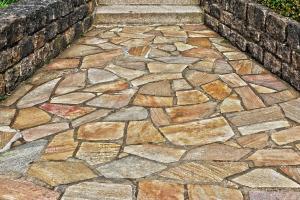Today we’re going to talk about hardscaping. What is that? In a nutshell, hardscaping is any non-living portion of your landscape. This includes sidewalks and driveways, retaining walls, patios or decks, gravel paths, and any other undead, er, non-living components. In our yard I’m going to be installing gravel pathways between my flowers beds soon.
Last summer I put down pieces of cardboard and covered them with the stump grindings the tree-removal company left behind at my parents’ house. It made for a charming walkway that kept me from getting too muddy when I moved the water around. The wood shavings are deteriorating now and returning to the soil, along with the cardboard, so I’m getting a lot of weeds and dirt starting to come through. I’ll document the process when I get the time to work on this project. This type of path has to be added after the beds around it are built, or maybe midway through the project depending on what kind of edging you plan to use. Still, knowing what you want to do with the pathway before you begin the project can help streamline the process.
I’ll document the process when I get the time to work on this project. This type of path has to be added after the beds around it are built, or maybe midway through the project depending on what kind of edging you plan to use. Still, knowing what you want to do with the pathway before you begin the project can help streamline the process.
The free-standing pergola we’ve got planned for the back yard this fall—if all goes well—also falls under the description of hardscaping. I’m hoping to train a woody vine up the side and across the top for shade, which will also soften the edges. Something like this could be made out of any number of materials from wood to vinyl to steel beams. The product we plan to have installed is called Alumawood—a wood-grain look in a metal beam with a steel center and a really great paint warranty. We’ve considered both vinyl and real wood for the project, but this product is stronger than vinyl, and less maintenance than wood, while it keeps the wood look.
We probably would have gone with redwood if we could have built it ourselves, it would have been considerably less expensive to do so, but my husband is really too busy with two jobs and I can’t build it alone. The fact that I won’t have to stain this structure every year or two to keep it looking great is a major bonus in my book. This is a project that has to be done before I can build the beds around it, or add grass, unless I want to make a mess of my landscaping.
Doing large projects like this first can really save you on stress and work down the road. And thirdly, we’ll be adding our flagstone patio and I plant to create a flagstone path through the grass out to where my poultry are kept. The patio will be installed first, then the path will be added before I bring in sod—a couple more steps down my landscaping plan, but I’ll buy all of my flags at once. I’ll do this to make sure I have enough matching flags to do all of the projects I have planned.

Image by Wolfgang Eckert from Pixabay
If you don’t get everything up front, you may not be able to get matching materials down the road, so plan ahead and save yourself some hassle. Neither of these flagstone pictures are from my yard–they are just to illustrate what I’m talking about. It’s a good idea to spend time looking at the kinds of projects others have done to get an idea of what you want in your yard.
I’ve got some other minor hardscaping projects planned, which have to be done before I start looking seriously at grass, but they aren’t a priority at this point. The key is to know which project you need to do first in order for your landscaping plans to flow the smoothest. If you have questions, you can speak with a landscaping contractor (especially if you are contracting out part or all of the project), or a gardening expert, like your local nursery.
Each step in my landscape plan is going to take time because I’m trying to heed the prophets’ admonitions to stay out of debt. I could haul in some top soil, throw out a bit of grass seed and forget the rest, or I could go into massive debt to have it all done this summer—the bank might even loan me the money against the value of my home. With the way the economy is going, and the massive numbers of homes going into foreclosure in some areas, I don’t want to be another statistic, and I don’t want to carry around a huge amount of debt.
I never want to move again, and hope to live here into my twilight years. That being the case, I want this yard to be a place of refuge from the world’s pressures, a place where friends and family can gather to enjoy a barbecue, an impromptu marshmallow roast or just a lazy summer afternoon in the shade. Because I know what I want, and I’m not in a huge hurry, I can take my time and put together the yard one piece at a time. I know it will be worth it.

Excellent advice and wonderful ideas. Maybe I can shape this landscaping up yet. 😉